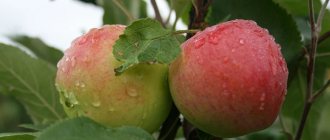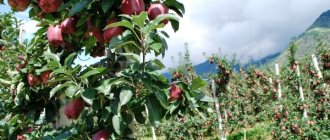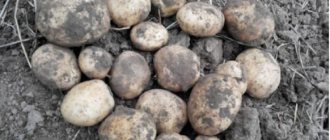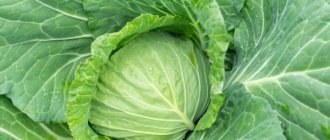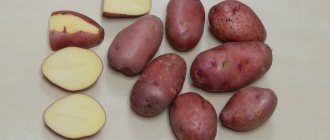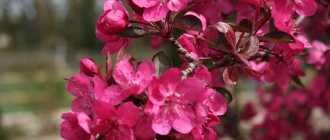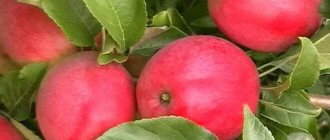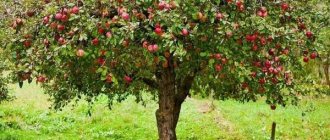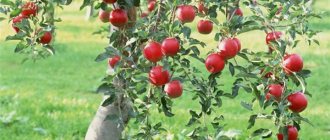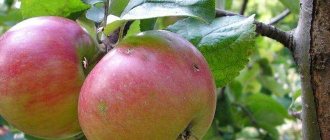Montoine apples
The Mantet apple tree variety will soon celebrate its centenary.
He began his triumphant path in 1928 in Canada. It quickly came to Russia, its ancestral home, since it was bred on the basis of a native Russian apple tree variety: Grushovka Moskovskaya. The Mantet apple tree has become popular due to the early ripening of its beautiful plump apples. Its range has reached far enough even to the north of the middle climatic zone, as far as a tree of average winter hardiness, like the Mantet apple tree, can withstand frosts. The Mantet apple tree is quite unpretentious not only to the climate, but also to the soil. It is lovingly grown by amateur gardeners; according to their reviews, they highly appreciate the irreplaceable qualities of the aromatic and sweet fruits. Apples of the Mantet variety are like a bright flying star: they amaze with their magnificent appearance, delicate taste and leave a pleasant memory of tasty morsels. They are stored for only a week or two, but are suitable for all kinds of preparations. An important advantage of the Mantet apple tree variety is that it is not only early-bearing, but also that after planting the tree begins to quickly bear fruit - in the third or fourth year.
Description and photo of the Mantet variety
The variety was first mentioned in 1928. At a breeding station in the city of Morden (province of Manitoba), as a result of natural pollination of apple trees of the Grushovka Moscow variety, Mantet was obtained. They quickly learned about it in Russia and began planting it in garden plots. As a result, the summer variety Mantet was included in the State Register for the Middle Volga and Central regions. Some gardeners, taking into account its similarity with Grushovka, claim that Mantet apples are tastier and larger in size.
Although the Mantet variety was obtained abroad, the source material for it was the Russian apple tree Grushovka moskovskaya
Tree
The Mantet apple tree is of medium height, oval-shaped crown, sparse. Its skeletal branches are distinguished by good strength and are directed upward. Large and juicy leaves have an ellipse shape and a leathery surface. The edges of the leaves are serrated, slightly raised. Most of the fruits are located on the ringlets. The shoots are brown, geniculate, and have small lentils.
This is what the Mantet apple tree looks like in early summer
Apples
The fruits are distinguished by increased juiciness and a pleasant dessert taste with a special sourness. Weight from 90 to 180 grams. They have a conical, oblong-round shape with some ribbing in the upper part. The skin is thin and smooth, yellow-green, but can also be yellow with a bright red blush. The funnel is small and narrow. The pulp is white and tender.
Mantet apples are very tasty and have a wide range of useful substances.
The fruits contain ascorbic acid, fructose, anthocyanins and pectins.
Description of the variety
The varietal characteristics of apple trees of the Mantet variety are visible in the structure of the silhouette of the tree and crown, the shape of the leaves, and the color of the flowers. The characteristics of a fruit tree variety are manifested by the characteristics of the fruit.
Wood appearance
The Mantet apple tree has a crown of medium height, not dense. It is enchantingly beautiful in the spring when it blooms, and gives a pleasant coolness in the summer in the shade of powerful skeletal branches. The leaves are oval, long, with elongated tips. Young annual stems of uniform thickness and medium vigor.
The apple tree of this variety is characterized by the fact that the fruits are mainly formed on the ringlets. The buds of the predominant white and pink background are shaded with purple. Opened, slightly elongated light pink petals form a large saucer-shaped flower.
Properties of fruits
At the end of summer, the young tree generously shares picturesque, appetizing apples, each weighing up to 180 g. In old trees, the fruits of the Mantet apple variety may be smaller, as well as the yield may be lower. Round-oblong greenish-yellow apples are slightly ribbed at the top. The outer color of the delicate skin of the fruits of this variety is a bright red blush, striped, with specks of a more saturated shade. It, as can be clearly seen in the photo, is often located on a bright orange-red background. The apple is not rough to the touch, with a delicate cover, and fully corresponds to its description.
The main advantage of summer apples of the Mantet variety is their exceptional sweetness, perhaps with the slightest hint of sourness. These are excellent dessert sweet apples with delicate white flesh and an unsurpassed aroma. According to the chemical composition of the fruits of the Mantet variety, the sum of sugars is 10.4%, 12.4% - pectin substances, 100 g of pulp contains 11.2 mg of ascorbic acid.
Features of fruiting
The early-fruiting apple tree variety Mantet is loved by gardeners due to its early ripening period. Under favorable weather conditions, apples begin to ripen from the end of July. True, their “reserves” on the tree run out quite quickly - by the middle of the next month. And if ripening is delayed, then they feast on the sweet fruits of the Mantet variety until the end of August. Unfortunately, fragrant fruits are not at all suitable for long-term transportation and storage.
Among the relative disadvantages of Mantet apple trees, one of the main ones is that the tree is susceptible to scab pathogens. This disease is more common in years with heavy rainfall and gloomy summer days.
Which varieties are the most productive?
Regardless of whether apples are sold or left for home consumption, any gardener is pleased to reap a rich harvest from a crop that he has cared for throughout the year. Therefore, the yield of winter varieties of apple trees is very important when choosing.
The most productive winter varieties of apple trees
- "Winter banana" is a high-yielding species. The apples are yellow in color, conical, but round with pronounced ribbing. The yield per tree is on average 250 kg, with the weight of one fruit being 150 g! The disadvantage of this variety is its short shelf life - until February.
- “Northern Sinap” is one of the most frost-resistant varieties. It is grown even in northern regions without insulation. Fruits in 5-8 years. The fruits are harvested in October, but they ripen completely only at the beginning of winter. You can collect up to 170 kg of fruits from a tree, each weighing around 120 g! The harvest is stored until May-June. The apples are glass-shaped, greenish-yellow, with a purple side. The disadvantage of this species is that sometimes there are even too many fruits on it so that the branches do not break; the excess ones are removed while they are still green.
- "Red Delicious" is a high-yielding variety. From a young tree they collect 25 kg, and from an adult tree - up to 150 kg of red-burgundy apples weighing 250 g each. The fruits have an excellent presentation and are stored for a long time (7 months). The shape is elongated, conical, but by the time of maturation they are rounded, segmentation becomes poorly distinguishable. Disadvantage: susceptible to bitter spot.
- “Winter lungwort” produces a rich harvest, which is stored until March, but with age the taste of the fruit becomes worse. The color of small apples, weighing 150 g, is yellow-green, red blush, blurry. The pulp is sweet, but somewhat bland, not very juicy - it is often used for processing. The tree bears fruit for 4-5 years. Productivity – 80 kg.
In addition, high-yielding varieties also include: “Jonathan”, “Lobo”, “Simirenko” described below.
Planting and care
Particular attention is paid to planting trees of the Mantet variety. Having decided in the fall that this tree will be planted in the garden in the spring, you need to prepare a place for it and dig a hole right away. Over the course of six to seven months, the soil compacts and accumulates moisture. This is the difference between the Mantet apple tree. For most other varieties, the holes can be prepared even a week, in other cases - a month before planting.
Proper tree planting
It is advisable to purchase 1-3 year old apple tree seedlings of the Mantet variety. These are the trees that take root best.
- The apple tree loves a sunny location and suffers in conditions of cold air flow and drafts;
- Apple trees of the Mantet variety should be planted in the spring, in more northern regions - at the end of April. In the south, planting is carried out until mid-October, starting from the third ten days of September;
- The Mantet apple tree prefers loamy soils. This is the most suitable soil for it, but it will grow on others if well cared for;
- If several trees are planted, the minimum distance between them is four meters. A hole with a diameter of 50 cm to 1 m is dug at least 70 cm deep, nut shells are placed down;
- During planting, first fill up with fertile soil, then a layer in which humus, compost or peat are mixed. Sand must be added to clay soil. If the soils are acidic - up to one kilogram of lime. A mound is made from this mixture, where the seedling is placed, carefully spreading the roots along the sides. Sprinkle with the same composition;
- Addition of mineral fertilizers: 35–45 g of potassium sulfate, 30–40 g of potassium salt, 80–100 g of superphosphate;
- The earth is compacted well, two buckets of water are poured near the trunk and two buckets are poured out. Then mulch with leaves or humus.
Basic stages of apple tree care
Good care will significantly improve the formation of the tree from a very young age and increase its productivity. The tree will gratefully respond to care for its condition, and it is not at all complicated.
- The Mantet apple tree needs to be watered once every seven days. The volume of water for one tree is from 20 to 40 liters, depending on the weather;
- After watering, slight loosening of the tree trunk circle is necessary;
- Although the crown of the Mantet apple tree variety is sparse, autumn pruning of branches that grow inward, as well as damaged and annual ones, will only increase the yield of the tree;
- Considering the high yield of the variety, it would not be superfluous to garter the branches with fruits. Otherwise, the branch may break off, not only the fruit will suffer, but also the tree itself;
- In spring, hunting belts are put on the trunk. They will protect the tree from the apple blossom beetle and ants.
Chemistry helps: how to deal with scab and other diseases
The tree is sprayed with appropriate preparations against diseases and harmful insects. You can find a lot of chemicals on sale now. You just need to carefully follow the instructions when using them. Natural compounds will also come to help in preserving the harvest. Since the Mantet apple tree is threatened by a fungal disease, it is treated with effective mixtures.
- Prepare a solution: 2 liters of hot water and two hundred to three hundred grams of chopped garlic, leave for 24 hours. Strain, add 30 g of grated laundry soap and 8 liters of water;
- In the spring, they are treated with Bordeaux mixture (9 liters of water, 300 g of copper sulfate, 400 g of quicklime): 2 liters will be used for a young tree up to 6 years old, up to 10 liters for an older tree;
- Fungicides Horus and Strobi are widely used. The first - for the prevention of spotting, scab and moniliosis - is used twice: when the flower buds have not bloomed and at the end of flowering. The second fights sooty fungus and powdery mildew, spraying is carried out 3 times.
On almost every plot, be it a peasant farm or a summer cottage, you can find seedlings of various apple trees. Hundreds of new varieties have been developed. But we don’t want to forget the old successful varieties because of their wonderful fruits.
Landing Features
The place where you are going to plant the Mantet apple tree should be well lit by the sun, but at the same time protected from drafts and free from stagnant cold air.
Planting can be done in both spring and autumn. The main rule is that this should be done during the dormant period of the plants. In the spring, this is done before the buds open and the earth is completely warmed up, and in the fall - before the first frost. In any case, the apple tree needs to be provided with additional watering, because it will need moisture most at this moment.
The experience of gardeners suggests that the best planting material is seedlings aged from one to three years - such trees quickly and actively begin to develop.
Rotten and damaged roots must be removed, as well as broken branches.
The best soil for the Mantet apple tree is loam, but it can also be successfully grown on other types of soil if you follow the timing and planting rules and provide proper care.
First of all, you need to properly prepare the planting hole. It is dug up several months before planting the seedling so that the soil becomes denser, absorbing as much moisture as possible. This is some difference between the Mantet variety and other varieties, for which it is recommended to dig a hole a week or, at most, a month before planting.
The top layer of soil is laid down along with organic matter, and the bottom infertile layer is mixed with mineral fertilizers
The size of the hole depends on the type of soil on your site and how prepared it was at the time of digging. For example, on fertile, dug up soil, the dimensions of the hole will be as follows: 40 cm in diameter and 30–35 cm in depth. If the planting site has not been cultivated for a long time or the soil itself is heavy, the dimensions of the hole will be as follows: 70 cm in diameter and a meter deep. There is a third option, in which the soil contains chalk clay, marl and crushed stone, and the ground has not been dug up - in this case, the dimensions of the hole will be 1–1.2 meters in diameter and a meter deep.
The dug hole is filled with fertile soil, and the top layer of soil is mixed with peat, humus, compost or rotted manure (any of these components is taken in the amount of 3-4 buckets per tree). For clay soil, use sand in the volume of one bucket. The resulting mixture is laid out at the bottom of the hole so that it forms a mound on which the tree will be placed when planting.
Now comes the turn of mineral fertilizers. One pit requires a mixture consisting of potassium salt (30–40 g), potassium sulfate (35–45 g) and superphosphate (80–100 g). We mix this composition with soil taken from the lower infertile layer.
Cover the roots of the seedling evenly with soil when planting and shake the tree periodically to prevent voids from forming.
We place the apple tree seedling on a mound and carefully straighten all the roots in different directions, after which we cover it with a mixture of soil and mineral fertilizers. This should be done slowly so that the soil evenly fills the voids between the roots. After the hole is filled, we trample it in the circle around the trunk and add soil until a small mound is formed. Now all that remains is to water the tree generously, using 15–20 liters of water, and mulch the planting site with humus or leaves 1–2 cm thick. Within two to three weeks, the earth will compact and subside, and thanks to the mound built on top, a failure will not form near the trunk of the seedling.
A young apple tree has a thin trunk that can bend and break under the influence of strong winds, so tie the seedling to three pegs after planting.
Reviews
Evgeniy D., 54 years old, Orel
My family really likes this variety of apple tree because of its precociousness. It is clearly evident that the Mantet and Grushovka apple trees are relatives. But the daughter has a much more elegant aroma, and the taste is sweet, pleasant, and there is nothing to say. I recommend everyone to have this tree in their dacha!
Antonina Igorevna, 65 years old, Velikie Luki
The Mantet apple tree has been growing on our site for 16 years. We purchased a seedling from a nursery and liked the description of the variety and the photo. Scab was treated every year. Yes, this year somehow it didn’t work out to get everything done. Didn't spray. And there are a lot of fruits - good, not affected.
Yulia V., 29 years old, Voronezh region, Kalach
My father and I planted the first seedling of the Mantet variety ten years ago. Apples in summer are everyone’s favorite treat. What a delicious jam! This is an excellent filling for pies in winter. Now parents really like to bake them, their age is such that they need to think about the right food. My husband and I have planted the Mantet apple tree at home for 5 years now. We have been trying our delicious apples for two years now. You won't find a better variety for summer!
Winter varieties of apple trees
Winter varieties of apple trees
Jonathan . American variety of apple trees. The fruits are harvested at the end of September - beginning of October. Trees of medium size. The branches are thin, multiple, with drooping ends. During the period of fruit formation, it appears on a vigorous rootstock in the 5th-6th year, on the EM-IV rootstock in the 4th year, EM-IX in the 3rd year. The apple yield of this variety is significant. Trees in the age group of 18-22 years produce 180-250 kilograms of apples. The fruits are medium-sized, homogeneous, round-conical in shape, weighing up to 110-160 grams. The skin is smooth, dense, with a faint fragrance, greenish-golden when picked and golden-yellow in storage, almost without exception covered with a beautiful bright red blurred blush and carmine stripes. The pulp is yellowish in color, dense, fine-grained, tender, juicy, with an attractive fragrance. The fruits remain until March-April. The main flaw of the variety: the trees suffer greatly from powdery mildew. Pollinators of apple trees of this variety: Calvil snowy, McIntosh, Parmen winter golden and Renet Simirenko.
Delicious . American variety of apple trees. The fruits are harvested at the end of September - beginning of October. The trees are vigorous and quite resistant to powdery mildew. On a vigorous rootstock, trees begin to produce fruit in the 6th year. Harvests are relatively systematic and of great height. 15-year-old trees produce up to 200 kilograms of fruit per tree. It blooms flowers together with the main winter varieties, perfectly pollinating with them. The fruits are large, weighing up to 130–180 grams, conical or round-conical in shape, with a ribbed top. The color of apples is yellow-green with an elegant dark red blush covering almost the entire surface of the fruit. The pulp of the fruit is creamy, dense, juicy, with a strong fragrance, sweet; the fruits are transportable and shelf-stable (stored until April).
Wagner prize money . American apple variety. The fruits are harvested at the end of September. The trees are weak-growing. During the period of fruit formation, trees grafted on seedlings enter the 4th-5th year, and in the paradise - in the 3rd year. The yield per tree is 25–120 kilograms of fruit, life expectancy is 25–30 years, the variety is resistant to frost and can withstand drought well. The mass of fruits is of medium size - up to 120-150 grams, flat-round in shape. The skin is not very sensitive to pressure and shock. The pulp is white, with a yellowish tint, tender, fine-grained, juicy, with an excellent wine-sweet taste. Fruit ripeness appears from mid-November. The fruits are transportable and stored until April. Pollinators: Mackintosh, Renet of Landsberg.
Climber . Kabardino-Balkarian variety of apple trees, medium-sized. The fruits are harvested in the second half of September. 8-10 year old trees produce 80-90 kilograms. Fruit formation is systematic. The fruits are somewhat similar to Renet Simirenko, large, weighing 160-200 grams. When ripe, they acquire an elegant yellow color. The pulp is greenish or yellowish, juicy, excellent dessert taste with satisfactory acidity even at the end of storage. Stored until June. Pollinators: Jonathan, Delicious, Wagner's prize.
Mantuan . Western European variety of apples. The fruits are harvested in the second half of September. The trees are medium-sized, capable of withstanding unfavorable winter conditions, resistant to diseases, and undemanding to soil and location. The period of fruit formation begins when grafted on wildflowers in the 7th-8th year, on dusena - in the 5th-6th year, and in paradizka - in the 4th-5th year. The yield from an apple tree of this variety is 250-400 kilograms. The average weight of apples is 90-100 grams. The skin is dense, ripe fruits are yellow in color, with a thick red blurred blush on the sunny side. The pulp is white, tender, crumbly. The fruits are ready for consumption in December and last until April-May. Pollinators: Wagner prize, Renet Simirenko.
Currently, fruit growers in many countries are concentrating significant attention on apple tree varieties of the “Spur” type, associated with changes in the size of the tree, the nature of fruit formation and the timing of fruit formation in comparison with the original varieties. It is believed that these varieties of apple trees will be the basis of industrial gardening in the future, because trees of this type are natural dwarfs and are 1/3 smaller than the original varieties.
The name “Spur” is English, it means “spur” and is associated with the external appearance of the trees, the peculiarity of which is weak branching, almost continuous fouling of the main branches with short fruiting branches such as ringlets. The shoots of such trees are generally shorter, thicker, with shorter, more multiple internodes. Varieties like “Spur” very quickly enter the period of fruit formation and bear fruit generously.
Apple tree Mantet: description and characteristics of the variety, planting and cultivation with photos
The Imant apple tree was bred by a group of scientists at the Belarusian Research Institute of Fruit Growing in 1999, but was included in the State Register of this country only in 2010. At the same time, the long absence of official recognition did not prevent the variety from gaining wide popularity not only in its homeland, but also abroad, in the republics of the former USSR. Imant is especially popular in Russia, Moldova and Ukraine.
The fruits of the Imant apple tree immediately attract attention due to the unusual shade of the skin.
This variety cannot be grown in most parts of Russia due to its insufficient frost resistance. Imant will not survive the continental climate of the Urals, Siberia, and the Far East. But the conditions of the Volga region, Moscow region, even the North-Western region, and even more so the Black Sea region, are very suitable for this apple tree.
The Imant apple tree is characterized by early fruiting - trees can begin to bear fruit in the 3rd year after planting
The “parents” of Imant were Antey (one of the most popular Belarusian varieties) and Liberty (originally from the USA). Both of them belong to the winter category.
The first is specially noted in the Belarusian State Register as especially valuable in terms of productivity and economic properties; from the second, the hybrid inherited keeping quality, excellent taste and resistance to powdery mildew.
Additionally, breeders introduced a gene that protects their creation from a fungus that causes scab.
From his “parents” Imant inherited productivity, keeping quality, and disease resistance
The Imant apple tree is no different in size and growth rate. The crown is medium dense, slightly “spreading”. Because of this, the tree looks a little like a broom placed on the handle. Maximum height - 2.5–3 m. Fruiting type is mixed. Apples are formed both on young annual branches and on the so-called spears and ringlets.
The Imant apple tree is one of the most successful creations of Belarusian breeders
The fruits ripen in September or early October. Imanta's yield is not bad; an adult tree (over 5 years old) produces 25–30 kg of apples annually. The fruits are aligned, one-dimensional, the ribs can be easily felt, especially closer to the base.
The average weight of the fruit is about 170 g. The taste is pleasant, sweet and sour, with a faint aroma. The main tone of the skin is greenish, but it is completely hidden by a rich crimson “blush”. From a distance, Imant apples appear purple.
The pulp is vanilla-cream color, not very dense texture, fine-grained, juicy.
Professional tasters rate the taste of Imanta 4.3 points out of 5. But many amateur gardeners consider this rating to be too low. The full flavor is revealed by the New Year or even by the end of winter; apples ripen during storage.
Advantages and disadvantages of the variety
Among the advantages of the Imant variety are:
- Good frost resistance, quite sufficient for cultivating this apple tree in the European part of Russia. Imant can withstand cold temperatures down to -25ºС; leaf and flower buds rarely suffer from recurrent spring frosts.
- Having immunity against scab. If the summer is cool and rainy, it is almost impossible to protect trees from it. The disease-causing fungus could greatly reduce future harvests. In addition, Imant rarely suffers from bacterial cancer, cracking of the bark, and is almost not susceptible to gum development.
- Precociousness. The first apples from a standard tree are tasted in the 3rd year after the seedling is planted in the ground.
- Good survival rate of trees.
- Compact and unthickened crown. This greatly facilitates pruning, preventive treatment of the tree against various pests, and harvesting.
- General attractiveness, large size and unusual appearance of apples. Coupled with keeping quality and excellent transportability, this makes Imant a promising variety not only for cultivation on personal plots, but also for cultivation on an industrial scale. Even in conditions other than optimal, apples can survive until the spring of next year.
The Imant apple tree does not suffer from scab even when the weather is very favorable for this
The Imant variety has virtually no disadvantages as such. Not everyone likes the unusually dark skin, dense crispy flesh and taste, but this is a matter of personal preference. They also sometimes complain that the characteristic aroma is almost not felt. It is also noted that with insufficient watering, if the summer is hot, the fruits vary greatly in size and shape.
Imant apples look quite unusual; not everyone likes the dark skin
Source: https://KinzaRostov.ru/frukty/yablonya-mantuanskoe.html
Winter varieties of apple trees
In this article I will tell you about winter varieties of apple trees, or rather about some of them, the most famous.
Jonathan
Jonathan is an American winter apple variety. The fruits are harvested at the end of September - beginning of October. Trees of medium size. The branches are thin, multiple, with drooping ends. During the period of fruit formation, it appears on a vigorous rootstock in the 5th-6th year, on the EM-IV rootstock in the 4th year, EM-IX in the 3rd year.
The apple yield of this variety is significant. Trees in the age group of 18-22 years produce 180-250 kilograms of apples. The fruits are medium-sized, homogeneous, round-conical in shape, weighing up to 110-160 grams.
The skin is smooth, dense, with a faint fragrance, greenish-golden when picked and golden-yellow in storage, almost without exception covered with a beautiful bright red blurred blush and carmine stripes. The pulp is yellowish in color, dense, fine-grained, tender, juicy, with an attractive fragrance. The fruits remain until March-April.
The main flaw of the variety: the trees suffer greatly from powdery mildew. Pollinators of apple trees of this variety: Calvil snowy, McIntosh, Parmen winter golden and Renet Simirenko.
Delicious
Delicious is an American winter apple variety. The fruits are harvested at the end of September - beginning of October. The trees are vigorous and quite resistant to powdery mildew. On a vigorous rootstock, trees begin to produce fruit in the 6th year. Harvests are relatively systematic and of great height. 15-year-old trees produce up to 200 kilograms of fruit per tree.
It blooms flowers together with the main winter varieties, perfectly pollinating with them. The fruits are large, weighing up to 130–180 grams, conical or round-conical in shape, with a ribbed top. The color of apples is yellow-green with an elegant dark red blush covering almost the entire surface of the fruit.
The pulp of the fruit is creamy, dense, juicy, with a strong fragrance, sweet; the fruits are transportable and shelf-stable (stored until April).
Wagner prize money
Wagner prize is an American winter apple variety. The fruits are harvested at the end of September. The trees are weak-growing. During the period of fruit formation, trees grafted on seedlings enter the 4th-5th year, and in the paradise - in the 3rd year. The yield per tree is 25–120 kilograms of fruit, life expectancy is 25–30 years, the variety is resistant to frost and can withstand drought well.
The mass of fruits is of medium size - up to 120-150 grams, flat-round in shape. The skin is not very sensitive to pressure and shock. The pulp is white, with a yellowish tint, tender, fine-grained, juicy, with an excellent wine-sweet taste. Fruit ripeness appears from mid-November. The fruits are transportable and stored until April.
Pollinators: Mackintosh, Renet of Landsberg.
Climber
Climber - an apple tree variety bred in Kabardino-Balkaria, medium-sized, belongs to the winter varieties of apple trees. The fruits are harvested in the second half of September. 8-10 year old trees produce 80-90 kilograms. Fruit formation is systematic.
The fruits are somewhat similar to Renet Simirenko, large, weighing 160-200 grams. When ripe, they acquire an elegant yellow color. The pulp is greenish or yellowish, juicy, excellent dessert taste with satisfactory acidity even at the end of storage. Stored until June.
Pollinators: Jonathan, Delicious, Wagner's prize.
Characteristic
Tree height
Average, 4–4.5 meters . This variety is not very vigorous, which is an advantage for small areas.
Crown
- Oval shape,
- Quite rare
- With strong, upward-pointing skeletal branches.
Leaves
- Large,
- Leathery, shiny,
- With serrated edges.
Bloom
- Soft pink with a lilac tint,
- Fragrant,
- Very large.
Fruit
- Medium size, 120-160 gr.,
- Round-oblong shape with slight ribbing at the base,
- Yellow-green in color with a bright red speckled blush.
- The taste is dessert, sweet with a slight sourness.
- The pulp is juicy, white, tender, with a pleasant aroma.
Mantet is considered the most delicious apple of the early ripening varieties..
Tasting assessment
Harvest ripening time
The end of July, but with cloudy, cool summers it can shift until mid-August.
Productivity
Above average, with good care reaches 150-170 kg per tree . Without special care, the yield is reduced to 80-100 kg.
The peak of productivity begins at the age of 15, lasts up to 30-40 years and gradually decreases.
Winter hardiness
Average, no more than – 25°. The variety is not recommended for cultivation in the Northern regions .
Disease resistance
Medium, scab resistance is low. The apple tree suffers from this fungal disease when the weather is favorable for scab: during a humid, rainy summer or autumn.
Ripening of Mantet apple fruits.
Delicious.
Delicious is an American winter apple variety. The fruits are harvested at the end of September - beginning of October. The trees are vigorous and quite resistant to powdery mildew. On a vigorous rootstock, trees begin to produce fruit in the 6th year. Harvests are relatively systematic and of great height. 15-year-old trees produce up to 200 kilograms of fruit per tree. It blooms flowers together with the main winter varieties, perfectly pollinating with them. The fruits are large, weighing up to 130–180 grams, conical or round-conical in shape, with a ribbed top. The color of apples is yellow-green with an elegant dark red blush covering almost the entire surface of the fruit. The pulp of the fruit is creamy, dense, juicy, with a strong fragrance, sweet; the fruits are transportable and shelf-stable (stored until April).
Landing
In order for the apple tree to grow well and delight you with the harvest, you need to plant it correctly and care for it.
During the season, the apple tree needs watering (if there is no rain for a long time), removing weeds from the tree trunk, pruning and fertilizing.
To plant a tree, you need to choose a dry place, protected from strong winds.
It is unacceptable for groundwater to stand close (closer than 2.5 meters).
The apple tree grows well in fertile, breathable soils. In terms of structure, loams, chernozems and podzolic chernozems are well suited .
Feeding
When planting in spring, add the following to the planting hole:
- 1-2 buckets of humus or compost;
- 50-80 gr. potash fertilizers;
- 100-200 gr. superphosphate;
- 50-70 gr. nitrogen fertilizer (urea, ammonium nitrate, ammonium sulfate).
When planting in autumn, humus and nitrogen fertilizing are not applied; only potassium and phosphorus fertilizers are added.
The apple tree is always fed according to the same scheme:
- In spring - nitrogenous fertilizers,
- In autumn - potassium-phosphorus.
Trimming
Performed in early spring before buds begin to bloom or in autumn after the first frost.
When planting, the branches of the apple tree are shortened by a third of their length.
Every year, downward growing branches that are crooked and thicken the crown are removed.
You should not remove more than a quarter of the branches in one pruning
Watering
Young trees especially need watering - in the first year after planting, they are watered once every 2 weeks if the weather is dry. For one watering, 2-3 buckets of water are consumed.
An adult tree is watered 4-5 times per season, using 7-10 buckets of water.
Nuances of care
Caring for an apple tree of the Mantet variety is no more difficult than for other varieties: this includes loosening the soil in the trunk circle, removing weeds, periodic timely watering, whitewashing the trunk with slaked lime and regular fertilizing.
The apple tree needs to be watered once a week. One mature tree requires 20-25 liters of water. It is undesirable to use a larger volume and frequency of watering; the tree does not like excess moisture.
Once a year, apply fertilizer consisting of humus (1–2 kg), potassium sulfur (20 g) and superphosphate (50 g). Potassium sulfur can be replaced with wood ash (100–150 g).
To maintain fruiting at a good level, it is useful to carry out rejuvenating pruning every autumn. Remove old, broken, damaged and annual shoots. It would be useful to prune branches that thicken the crown (growing inward, at the wrong angle, crossing). With such pruning, the apple tree will spend energy on fruit-bearing branches, and the non-thickened crown will receive a sufficient amount of sun.
It is useful to tie up the fruiting branches of the Mantet apple tree to avoid them breaking off under the weight of the harvest.
Since the Mantet apple tree is especially susceptible to scab, periodic spraying with natural or chemical agents is necessary as a preventive measure. Among the first is garlic tincture. 200–300 grams of garlic are crushed, poured with two liters of hot water, left for a day, then filtered and diluted with eight liters of cold water, adding 30 grams of laundry soap.
A popular remedy not only for prevention, but also for active control of scab is Bordeaux mixture, which is taken at the rate of 2 liters per tree under six years old and 10 liters per adult apple tree. To do this, dissolve 300 grams of copper sulfate and 400 grams of quicklime in 9 liters of water. Spraying with this composition is carried out in early spring.
The drug “Chorus” has proven itself well, used in a volume of 2 grams per 10 liters of water when used twice - during the “green cone” and “end of flowering” phases with an interval of 7-10 days. You can also use the drug “Strobi”, which, in addition to scab, will cope well with powdery mildew and sooty fungus. 2 ml of the substance is diluted in 10 liters of water and sprayed on the apple tree three times a season.
The drugs listed above can also be used to prevent other apple tree diseases such as moniliosis and blight.
Among the pests, one can note the leaf roller and the apple blossom beetle, as the most frequent guests on the apple tree. Against the first, use a solution of 400–500 grams of tobacco dust and 10 liters of water, which is infused for a couple of days, filtered, squeezed through a thin cloth and diluted with water (taken in a 1:1 ratio), adding 50 grams of soap to every 10 liters, and against the second, a set of measures is used in the form of collecting and burning leaves, digging up the soil, putting on hunting belts and manually collecting dried, unfallen buds (on young trees).
Photo gallery of means to protect apple trees from diseases and pests
Fungicide "Strobi" is good in the fight against scab
Hunting belts will come in handy to protect trees from the apple blossom beetle.
Tobacco dust helps get rid of leaf roller
Garlic tincture is a folk remedy for the prevention of scab.
"Horus" is one of the best drugs against scab
Bordeaux mixture is a universal remedy in the fight against scab, moniliosis and powdery mildew
Features of fruiting and ripening
Like most apple trees, the Mantet variety is self-sterile, i.e. to pollinate flowers, it needs another type of tree growing at a distance of up to 200 meters.
The best pollinators for the Mantet apple tree are considered varieties:
These apple trees bloom at the same time as Mantet - in mid-May.
The variety begins to bear fruit early:
- The first fruits appear 2-3 years after planting.
- The tree quickly increases its yield,
- Keeps it for 10-15 years.
- Gradually, the yield decreases, periodicity appears - after a fertile year, the apple tree “rests” the next year.
The more fruits there are on a tree, the smaller they will grow..
The Mantet variety is famous for its early fruiting: apples ripen earlier than most others - at the end of July in the southern regions and closer to the beginning of August in the central regions. The harvest ripens unevenly, the harvest time is extended by 2-3 weeks.
Wagner prize money.
Wagner prize is an American winter apple variety. The fruits are harvested at the end of September. The trees are weak-growing. During the period of fruit formation, trees grafted on seedlings enter the 4th-5th year, and in the paradise - in the 3rd year. The yield per tree is 25–120 kilograms of fruit, life expectancy is 25–30 years, the variety is resistant to frost and can withstand drought well. The mass of fruits is of medium size - up to 120-150 grams, flat-round in shape. The skin is not very sensitive to pressure and shock. The pulp is white, with a yellowish tint, tender, fine-grained, juicy, with an excellent wine-sweet taste. Fruit ripeness appears from mid-November. The fruits are transportable and stored until April. Pollinators: Mackintosh, Renet of Landsberg.
Varieties
The variety is successfully grown on vigorous, semi-dwarf and dwarf clonal rootstocks. Which one is better to choose and what is their difference:
- On a dwarf rootstock, the tree will grow up to 2-3 meters in height, begin bearing fruit 2-3 years after planting and live 25-30 years.
- On a semi-dwarf rootstock, the apple tree will grow 3-4 meters in height, begin to bear fruit 2-3 years after planting and live 30-40 years
- On a vigorous rootstock, the tree will grow 5-6 meters in height, produce the first harvest 4-5 years after planting and live up to 60 years.
From a commercial point of view, it is more profitable to grow dwarf types of apple trees: they begin to bear fruit faster and are easier to care for.
In addition, instead of one vigorous apple tree, you can plant as many as four different dwarf varieties to diversify the taste and ripening time of the crop.
If you want a very tall apple tree, like in the gardens of our grandmothers, choose an apple tree on a seed rootstock.
Its advantages:
- It grows over 7 meters in height,
- Unpretentious and resistant to adverse environmental factors,
- Fruits for 40-50 years.
The disadvantages of such apple trees include:
- Late entry into fruiting - 7-10 years after planting.
- Inconvenient care: pruning, harvesting, pest control.
- The quality of apples is lower than that of low-growing and medium-growing varieties.
Columnar apple trees are less winter-hardy ; the upper part of their trunk often freezes.
The tree begins to bush and the yield decreases. They should be given preference in warm regions with non-cold winters or covered for the winter with a white covering material: lutrasil or spandbond.
Columnar apple trees.
The advantages of the columnar type are that it begins to bear fruit in the second year after planting and the compactness of the crown.
Apple tree varieties photo with name and description
It is grown even in northern regions without insulation. Fruits for a year. The fruits are harvested in October, but they ripen completely only at the beginning of winter. Mobile app. Catalog. Industrial and wholesale goods. Agricultural products, machinery and equipment. Fruit and vegetable crops. Seeds, seedlings and seedlings of fruit and berry crops.
Is the information out of date? All seller offers. In stock. Ukrainian Nova Poshta. Discount for another 6 days. Wholesale prices 28 UAH. Loan from our financial partners. Add to favorites. Write to the seller. Seller from: Khotyn district, Bochkovtsy village. Schedule. Delivery methods Pickup, courier delivery.
Return conditions.
Is it suitable for the Moscow region?
The Mantet apple tree is included in the register of varieties suitable for cultivation in the Central region of Russia , which includes the Moscow region.
The Mantet apple tree is not highly winter-hardy and can freeze in particularly harsh winters .
How to minimize the risk of freezing:
- Select a seedling grown at a local nursery .
- For planting, choose a sunny place, avoiding lowlands and heavily windy areas.
- For the first three years, cover the seedling without winter.
Useful tips
- To find out at what depth to plant a seedling, look at the grafting site: it should be 5-7 cm above the soil level.
- In the year the apple tree first blooms, it is better to leave 1-3 flowers on it and pick off the rest. The strength of a young tree is not enough to grow shoots and bear fruit at the same time.
- If the soil on the site is heavy and oily, dig a large planting hole: 70-80 cm deep and 60-80 cm wide. You need to add 3-4 buckets of sand to the soil removed from the hole, and fill the hole with the prepared mixture when planting. The sand will loosen the soil, making it easier for the seedling to grow.
Everything is good, the fruits are tasty, the apple tree produces fruits abundantly. But I got Porsha and processed it and still got caught. What else can be processed?
As a rule, it is not possible to get rid of a disease such as scab with a one-time treatment. A set of measures is needed here. How and with what methods to combat scab on an apple tree is described in the article Scab on an Apple Tree. Read and follow all instructions. And you can forget about scab forever.
Treat with Bordeaux mixture, which contains calcium oxide and copper sulfate. It is sold in the form of a dry powder, which must be poured into a bucket of water and dissolved and sprayed on the tree in the spring, before the growing season.
